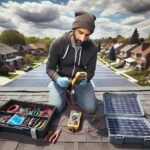Harnessing the power of the sun in Canada’s diverse climate might seem daunting, but it holds incredible potential. Did you know that installing solar panels on all suitable rooftops could meet up to 25% of Canada’s electricity needs? Even though common misconceptions about solar energy’s effectiveness in cold or cloudy weather, advancements in technology are breaking barriers and proving otherwise.
So, how can you maximize solar efficiency amidst snow-covered panels and varying sunlight hours? For starters, cities like Regina, Saskatchewan, receive up to 1,815 hours of peak sunlight annually, rivaling some of the world’s solar powerhouses. By leveraging these insights and debunking myths, you can unlock the true potential of solar energy in your home or business.
Ready to jump into the secrets that can transform your solar experience? Let’s explore how innovative designs and smart strategies are making solar energy a viable and sustainable option across Canada.
Understanding Canada’s Diverse Climate
Canada’s climate varies widely, influencing solar panel efficiency differently across regions. From the Atlantic provinces to the prairies and the mountainous west, each area has unique weather patterns. So, how can you optimize solar panels for life in this diverse environment?
 the ultimate checklist for installing solar panels in canada
the ultimate checklist for installing solar panels in canadaSeasonal Variations
Winter months pose challenges due to snow cover and shorter daylight hours. Snow accumulating on panels can significantly reduce efficiency. But, advancements in technology and design, such as self-cleaning and bifacial panels, are addressing these issues. In areas with heavy snowfall, consider solar panel models designed to handle these conditions. Don’t forget—clearing snow manually or with automated systems can also keep your solar lifestyle uninterrupted.
Regional Specifics
Southern regions like Ontario enjoy more annual sunlight hours when compared to northern regions. The solar potential here is higher, making solar panels a solid investment. Conversely, areas like British Columbia, known for overcast skies, benefit from panels that perform well in low-light conditions. Here, thin-film solar panels, which can capture diffused sunlight, might prove more effective.
Technological Advancements
Recent innovations have dramatically improved how solar panels function in cold climates. Canadian engineers and scientists are pioneering solar technologies tailored for local climates, including freeze-resistant materials and enhanced energy storage solutions. For example, smart inverters can optimize energy capture even during less-than-ideal weather.
Design Considerations
Orientation and tilt matter—south-facing roofs with a tilt angle appropriate to your latitude offer the best efficiency. Integrating solar panels with local architecture ensures optimal performance and aesthetic appeal. If you’re in an area with frequent snow, mounting panels at a steeper angle can help snow slide off more easily, enhancing your solar lifestyle.
Read also: the ultimate checklist for installing solar panels in canada
the ultimate checklist for installing solar panels in canada 5 tools every canadian needs for a successful solar panel diy
5 tools every canadian needs for a successful solar panel diyEconomic and Environmental Benefits
Aside from technological perks, installing solar panels contributes to reducing greenhouse gas emissions. You can take pride in not only lowering your utility bills but also supporting a cleaner environment. Isn’t that a win-win?
Make your transition to solar energy seamless by considering these factors. For more tips and expert advice, explore Solar Panels for Life and discover how you can make the most of Canada’s diverse climate with our tailored solutions.
Key Factors Affecting Solar Efficiency
Geographic Location
In Canada, geographical location significantly impacts solar efficiency. The farther north you go, the less sunlight you receive annually. Southern regions, like Ontario, enjoy more peak sunlight hours, enhancing solar panel productivity. Conversely, northern areas may face lower efficiency due to reduced sunlight. Urban centers like Regina benefit from substantial sunlight, making them ideal for solar installations. Rural areas also have less shading from buildings, contributing to better performance.
Solar Panels for Life offers solutions tailored to various regions, ensuring maximum efficiency regardless of your location. Ever wondered why some cities outperform others in solar energy production? It’s all about the latitude and local weather conditions. For example, Ontario’s longer days in summer boost overall solar capture, while British Columbia’s coastal clouds may necessitate specialized panels.
Read also: the ultimate checklist for installing solar panels in canada
the ultimate checklist for installing solar panels in canada 5 tools every canadian needs for a successful solar panel diy
5 tools every canadian needs for a successful solar panel diy why some canadian diy solar installs outperform pros
why some canadian diy solar installs outperform prosSeasonal Variations
Seasonal changes play a crucial role in solar efficiency. Winter poses challenges like snow cover and shorter daylight hours, reducing panel output. But, advancements like self-cleaning and bifacial panels mitigate these issues. In summer, longer days and clearer skies significantly boost efficiency, especially in regions like Saskatchewan.
Solar Panels for Life ensures that your system functions optimally throughout the year. Did you ever think snow could help solar panels? Reflective snow can bounce sunlight back onto the panels, enhancing efficiency. Technology adapts to seasonal variations, ensuring reliable solar energy year-round.
Weather Patterns
Weather patterns influence solar panel efficiency by affecting sunlight availability. Cloudy and overcast conditions can diminish performance. For instance, British Columbia often experiences overcast skies, necessitating thin-film panels for better efficiency. Conversely, clear and sunny days enhance solar output by maximizing direct sunlight exposure.
Solar Panels for Life designs systems optimized for diverse weather conditions, ensuring you get the most out of your investment. Have you noticed how some days your panels seem to work better? It all comes down to the weather. High-efficiency panels adapt better to changing conditions, maintaining consistent output.
Read also: the ultimate checklist for installing solar panels in canada
the ultimate checklist for installing solar panels in canada 5 tools every canadian needs for a successful solar panel diy
5 tools every canadian needs for a successful solar panel diy why some canadian diy solar installs outperform pros
why some canadian diy solar installs outperform pros the worst times to install solar panels in canada (and when to do it)
the worst times to install solar panels in canada (and when to do it)Curious to see how these factors impact your solar potential? Explore tailored solutions at Solar Panels for Life and begin on your solar lifestyle journey today.
Technological Innovations
Modern advancements in technology have elevated solar energy efficiency, making it more viable across Canada’s diverse climate. Let’s investigate into how specific innovations are transforming the solar world.
Solar Panel Types
Solar panels are the cornerstone of solar energy systems. But did you know there are multiple types designed to cater to various environmental conditions? Monocrystalline panels are popular for their high efficiency and sleek design. They’re particularly effective in regions with limited space but abundant sunlight, such as Southern Ontario. On the other hand, polycrystalline panels offer a balance between cost and efficiency and perform well in varied climatic conditions.
But it doesn’t stop there. Bifacial panels capture sunlight from both sides, boosting energy capture, especially in snowy conditions commonly experienced in Northern Canada. The reflective snow surface enhances energy collection, ensuring your solar lifestyle remains efficient year-round. Imagine getting up to 30% more energy output just because of the snow!
Inverters and Storage Solutions
You might’ve heard about inverters and storage solutions but wondered, “How crucial are they?” Let’s clarify. Inverters convert the DC electricity generated by solar panels into AC electricity that powers homes and businesses. There’s a variety of inverters, including string inverters, microinverters, and power optimizers. Microinverters are excellent for maximizing the energy output of each panel, especially in areas with shading issues.
Storage solutions, like lithium-ion batteries, are game-changers. They store excess energy generated during peak sunlight hours, allowing you to use it during nighttime or cloudy days. This technology is particularly useful in regions experiencing seasonal variations. With efficient storage, your home can maintain a steady supply of renewable energy, even during winter months.
Are you ready to explore your personalized solar solutions? Efficient inverters and advanced storage options ensure your investment in solar technology pays off. Visit Solar Panels for Life to discover how these innovations could fit seamlessly into your solar energy system.
Best Practices for Installation
Maximize your investment in solar energy with effective installation techniques. Implementing best practices ensures high efficiency and longevity for your solar panels.
Optimal Angles and Tilt
Determining the ideal angle and tilt for your solar panels isn’t guesswork—it’s a science. In Canada, the optimum angle generally equals the latitude of your location. This angle captures the most sunlight year-round. For instance, in Toronto, aim for a 43-degree angle.
But what about seasonal adjustments? While a fixed angle works well, consider a seasonal tilt. Adjusting the angle to be steeper in winter and flatter in summer can enhance efficiency. Want to take it a step further? Automated trackers adjust your panels’ tilt throughout the day, maximizing sun exposure.
But, remember, local weather conditions play a role. Snowy regions benefit from steeper angles, aiding snow slide-off and maintaining production during winter. While the upfront cost of automated systems may seem high, the increase in energy capture can make it worthwhile over time.
Site Selection and Shading
Choosing the right site for your solar panels isn’t just about open space. Site selection involves evaluating sunlight exposure, nearby structures, and vegetation. Even a small amount of shade can significantly affect performance.
Ever wondered why some panels underperform? Shading from trees, buildings, or even chimneys can disrupt energy generation. Use tools like solar pathfinders to assess potential shading issues throughout the year. Aim for minimal shading between 9 AM and 3 PM to ensure peak efficiency.
Also, consider roof condition and material. Solar Panels for Life recommends sturdy roofs made from composite shingles or metal, which offer better support and longevity. If the roof isn’t ideal, ground-mounted systems are a flexible alternative. Though they occupy more space, they allow for optimal placement and maintenance.
Reflective surfaces nearby, like light-colored gravel or snow, can also enhance performance by reflecting additional sunlight onto the panels. Thinking long term? Factor in tree growth and future nearby construction when selecting your site. Ensure your solar investment stands the test of time.
Ready to boost your solar lifestyle? Dive deeper into how Solar Panels for Life can tailor the perfect solution for your home.
Maintenance and Upkeep
Proper maintenance and upkeep are essential for maximizing solar efficiency in Canada’s diverse climate. Keeping your solar panels clean and regularly inspecting them ensures optimal performance and longevity, particularly when dealing with unique weather conditions across the country.
Cleaning Techniques
Maintaining clean solar panels is vital for optimal energy production. Dirt, bird droppings, and snow can reduce sunlight absorption, impacting efficiency. Use a soft brush or sponge with water to gently clean the surface, avoiding abrasive materials that might scratch the panels. (Wondering if it’s necessary?) Think about this: even a thin layer of dust can reduce efficiency by up to 5%.
For snowy conditions, a roof rake with a soft edge can help remove snow without damaging the panels. (Who wishes they could skip the hassle?) Consider investing in self-cleaning panels or systems that use advanced coatings to reduce the accumulation of dirt and snow, making maintenance easier.
Regular Inspections
Regular inspections ensure your solar system stays in peak condition. At least twice a year, check for visible damage, loose connections, and debris. Pay attention to wiring and mounting equipment for wear and tear. Are there any signs of corrosion or moisture infiltration? If so, address these issues promptly to avoid long-term damage.
During these inspections, monitor energy output against expected performance. A significant drop in output might indicate an underlying issue needing professional attention. (Isn’t it better to be proactive?) Schedule a professional inspection annually. Experts can identify and rectify problems you might miss, ensuring your solar panels from Solar Panels for Life remain at their best.
Maintaining your solar system doesn’t just optimize efficiency; it extends its lifespan, securing your investment. For tailored advice and solar solutions, explore offerings from Solar Panels for Life, ensuring a seamless solar lifestyle.
Financial Incentives and Government Policies
Revealing the full potential of solar panels in Canada often hinges on understanding the financial incentives and government policies available. These programs can significantly offset costs, making solar energy more accessible and attractive.
Federal Programs
The Government of Canada offers various initiatives to make solar panels more affordable. The Canada Greener Homes Grant, for example, provides up to $5,000 for energy-efficient retrofits, including solar panel installations. Have you considered how a grant could reduce your initial investment?
Federal tax credits also come into play. The Investment Tax Credit for Renewable Energy Systems allows for a 30% tax credit on installation costs. Could this be another reason to embrace a solar lifestyle? Besides, the Canadian Mortgage and Housing Corporation (CMHC) offers mortgage loan insurance rebates for homes incorporating energy-efficient systems.
Provincial Initiatives
At the provincial level, programs vary widely. Ontario’s net metering program lets you sell excess solar power back to the grid, offsetting future utility bills. This means your solar lifestyle could even generate income!
In Alberta, the Residential and Commercial Solar Program provides rebates of up to $0.75 per watt installed. Imagine the savings on a typical 5kW system. Meanwhile, Saskatchewan offers the Net Metering Rebate Program, covering 20% of eligible costs, up to $20,000. These provincial initiatives make installing solar panels not just eco-friendly but also financially savvy.
Incorporating these programs into your decision-making process can make solar panels a viable option regardless of your budget. Why wait? Explore how Solar Panels for Life can help you take advantage of these opportunities and transition to a greener, more cost-effective energy source.
Conclusion
Maximizing solar efficiency in Canada’s diverse climate is not only achievable but also highly beneficial. By leveraging advanced technologies and strategic design considerations, you can significantly boost your solar panel performance. Embracing financial incentives and government policies further enhances the feasibility and attractiveness of solar energy.
Whether you’re in sunny Ontario or overcast British Columbia, tailored solutions ensure optimal energy capture and cost savings. With proper maintenance and the right equipment, your solar investment will yield substantial returns, both economically and environmentally.
Explore customized solar options and take advantage of available incentives to make a seamless transition to renewable energy. Solar Panels for Life offers the expertise and solutions you need to harness the full potential of solar power in Canada.
